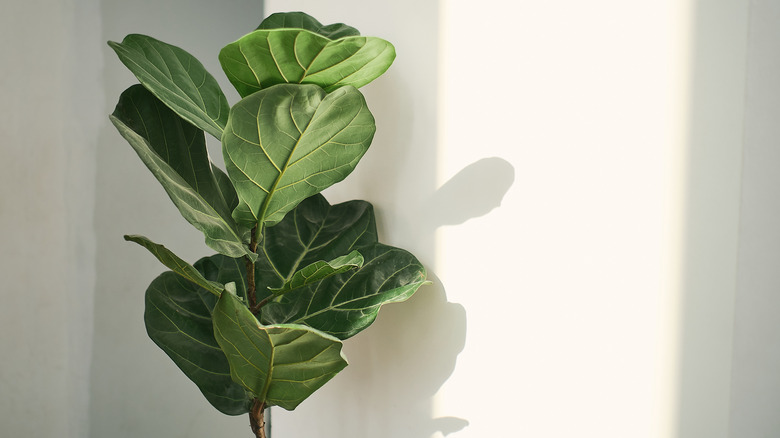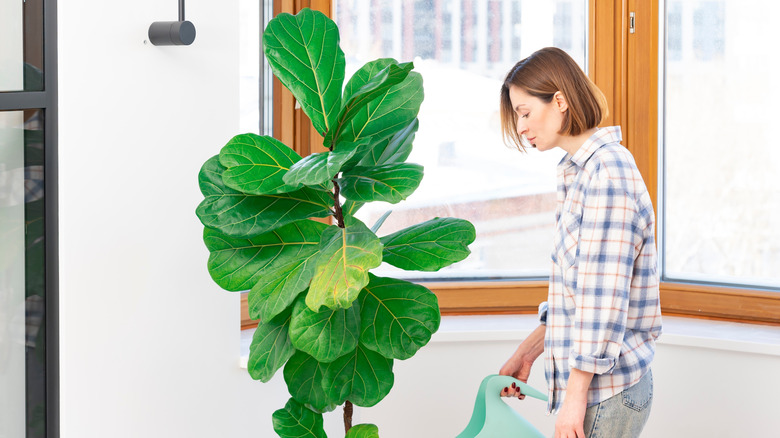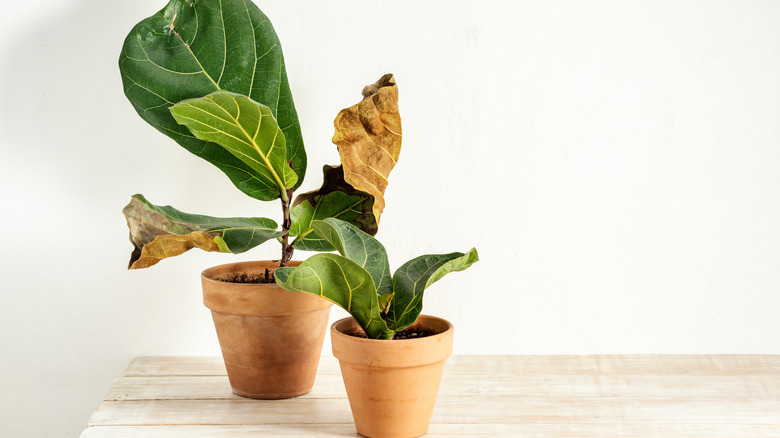How Often Should You Water An Indoor Fiddle Leaf Fig To Keep It Thriving?
Fiddle-leaf figs (Ficus lyrata) are beautiful, tall plants with distinct, large leathery leaves that are all over social media. While they make quite an impression in the home, they also require more care than your average houseplant. Known for their finicky nature, they thrive with a consistent watering routine. You should typically water your indoor fiddle-leaf fig every 7 to 10 days. This is a general rule, though, as other variables may alter this schedule, and checking the soil regularly will tell you whether the plant needs a bit of extra moisture.
Hailing from the rainforest, fiddle-leaf figs can grow up to 10 feet tall in your home with the right care. Their humid origins make them pickier than your average indoor houseplant, and this plays a role in how often you should water them. In their natural habitat, they experience significant bouts of moisture mixed with dry days, so they're sensitive to waterlogging. Yet they don't like to be too dry either, which is why fiddle-leaf figs aren't the best option if you're looking for low-maintenance beginner plants. Too much water leads to root rot, while too little of it results in dry, curling and damaged leaves. Incorrect watering is a common mistake with growing fiddle-leaf figs, but following a few simple tips, you can ensure a healthy, thriving plant.
Watering an indoor fiddle-leaf fig
To determine whether the fig needs water, use a moisture meter — it will end some of the guesswork. If you don't have a meter, use your fingertip, checking to see if the top 2 inches of soil are dry. Another method for testing the soil involves using a wooden skewer to assess the plant's bottom for moisture.
You can also estimate how much water your fig needs weekly based on its height. Generally, add 1 cup of water for plants shorter than 2 feet, 2 cups for plants taller than 2 feet, and 3 cups if the plant is between 3 and 6 feet high. Letting your fiddle-leaf fig sit in waterlogged soil can cause root rot, so adequate drainage is a must. So, give your fiddle-leaf fig as much water as it needs, let it drain through the bottom of the planter for 15 minutes, then remove the excess.
Keep an eye out for soil shrinkage, or soil pulling away from the pot, because this is a sign your plant is too dry. When in this state, the water will go to the interior of the pot instead of hydrating the root ball. Aerating the soil can help prevent this, as can keeping your fiddle-leaf fig moist but not soggy. Help the soil rehydrate by bottom-watering your houseplant, setting it in a dish or tub of water to soak up water through its roots. Pay attention to the season, as the fiddle-leaf fig has lower water intake during the low-light months of October to February. Adjust your watering style to accommodate its changing needs, so you don't make the plant too wet.
Signs your fiddle-leaf fig is thirsty or overwatered
Following the watering routine above should ensure you have a thriving indoor fiddle-leaf fig, but there may be times when you accidentally give it too much — or not enough — water. The signs of overwatering and underwatering in fig plants can overlap, making it difficult to differentiate between the two. To determine if your plant is too dry, see if your fiddle-leaf fig has curling leaves with brown spots at the edge throughout the plant. Meanwhile, signs of excess water leading to root rot can also include brown spots, but in the middle as well as the edge of the leaves. Yellowing, falling leaves are also an indicator, with the lower foliage dropping first.
In addition to watering your fig, give its leaves some moisture by misting it every time you water, since this plant loves humidity. A good practice is to mist the leaves when you water, taking care to wipe off any dust as well. You can run a humidifier or let your fig sit on a tray of wet pebbles when the indoor air is dry. With all of this in mind, it can feel daunting to properly water your indoor fiddle-leaf fig. Just try to be in tune with its needs and have patience. Once you start noticing and understanding the signs your plant displays, you can establish a good routine and keep it vibrant for years to come.


